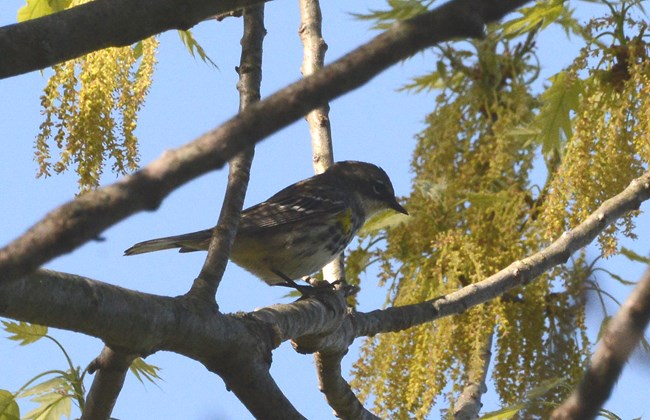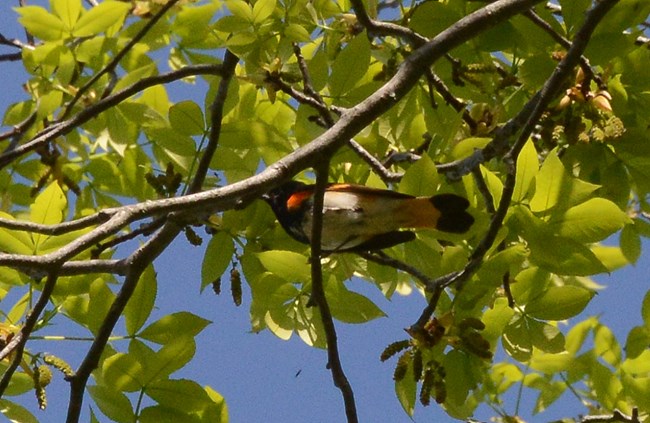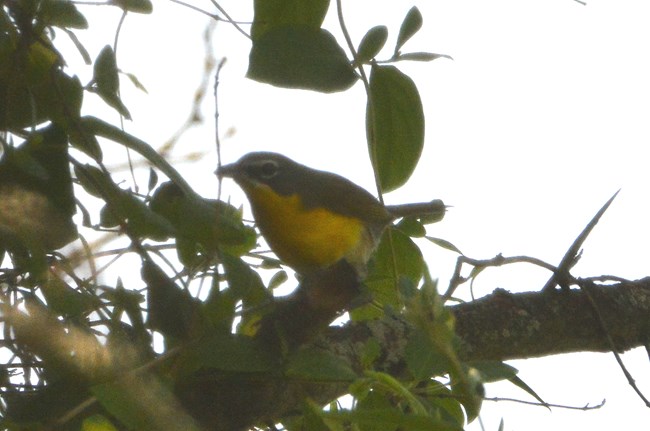|
NPS.gov / Park Home / Learn About the Park / Nature / Animals / Birds / Perching Birds
New World Warblers are a group of small and usually color perching birds that only live in the New World. These birds mainly live in woodland areas and use their delicate and small beaks to catch insects.

© Bill Telfair Yellow-rumped Warbler (Setophaga coronata)• Yellow-rumped Warblers are the only warblers that are able to digest the waxes that are found in bayberries and wax myrtles.• When male yellow-rumped warblers court females, they fluff their feathers, raise their wings and their wing feathers like a crown and then they from perch to perch chirping. • Female Yellow-rumped Warblers build nests in the shape of a cup using twigs, pine needles, grasses, and rootlets. They sometimes also use the hair of moose, horse, and deer, plus moss and lichens. • During the summer months, they love to eat insects like caterpillars, beetles, ants, grasshoppers and more. In winter they eat a lot of fruits and berries like bayberries and wax myrtle. Identification Information• Size: Sparrow sized or smaller (Extra Small/Small)• Color: In the summer both males and females are gray with flashes of white on the wings and yellow on their face, sides, and backside. Males have very bright and prominent coloring while females are duller in color and may have some brown. In winter the birds are a paler brown with a bright yellow backside and some yellow on the sides of their belly. 
© Bill Telfair American Redstart (Setophaga ruticilla)• As young males, American Redstarts have gray and yellow feathers like females until their second fall. Though these young males don’t have their colors yet they sing as best they can to try to have territories and attract mates. Some succeed but most of them do not get a mate until the next year when they develop their black and orange breeding feathers.• Male American Redstarts sometimes have two mates at the same time. Most polygamous (having more than one mate) bird species have two females that nest in the same territory but redstarts have two seperate territories that can be as far away as a quarter-mile. • During the early stages of courtship, the male shows the female a variety of potential nest sites. She tests out many sitting by settling into them and moving around. After much trial and error she finally chooses one she likes. • American Redstarts love to eat insects like leafhoppers, planthoppers, flies, moths and their larvae, wasps, and beetles. They will also eat berries and fruit like barberry, serviceberry, and magnolia. Identification Information• Size: Sparrow sized or smaller (Small)• Color: Adult male American Redstarts are mostly black with bright orange patches on their sides, wings, and tail and they have a white belly. Females and young males have yellow or yellow orange where males have bright orange. They also have gray heads and bellies with dark green backs, wings, and a gray trail. 
© Bill Telfair Yellow-breasted Chat (Icteria virens)• Chats love to eat spiders and insects like beetles, bugs, ants, bees, mayflies, cicadas, moths, and caterpillars. They sometimes also eat fruits and berries like strawberries, blueberries, blackberries, raspberries, and elderberries.• During the breeding season, to impress a potential mate, the males display by descending from a high perch while singing and they are also usually doing fancy wingbeats with their tail drooping. At the end of their display they make a thumping sound with their wings. • To build their nests, females build a cup shaped nest with grasses, leaves, bark strips, and weed stems. They then line the nest with plant stems, fine grasses, pine needles, and sometimes roots or hair. • Though chats are in the warbler family, they are larger than other warblers, are able to learn and remember more songs and calls and also they have different behaviors and anatomy than those of warblers. Identification Information• Size: Between sparrow and robin (Small)• Color: Chats are a murky green on their backs and wings and they have a bright yellow neck and chest. They have a gray face with a white eyering and they also have a white mustache stripe that is on their cheeks. Their lower belly is white.
All of the above information is an abbreviated version of information gathered from the Cornell Lab of Ornithology. Please visit their website for more in-depth bird information.
|
Last updated: September 16, 2019
